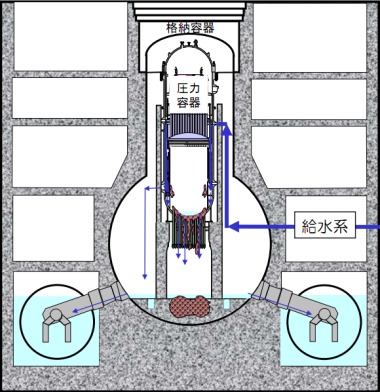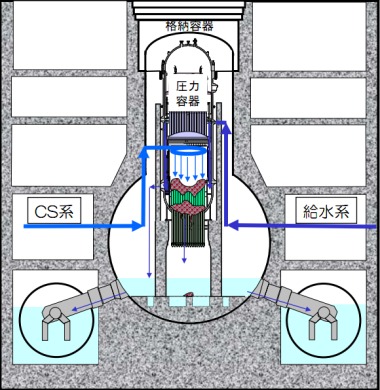A new analysis of the accident at Fukushima Daiichi indicates more extensive melting probably occurred at unit 1 than previously thought, although the predicted status of units 2 and 3 remains about the same.
The bulk of unit 1's nuclear fuel went through the bottom of the reactor vessel as well as about 70 centimetres of the drywell concrete below, according to the analysis released today. However, the corium did not breach the steel containment vessel 1.9 metres further down within the concrete, or the boundary of secondary containment some 7.6 metres further still.
Of the 10.2 metres of solid concrete that makes up the floor of the reactor building, the corium is thought to have melted and mixed with the first 70 centimetres only. The natural spreading and expansion of the corium, plus the addition of compounds of concrete, would have reduced the intensity of the heat produced until it reached an equilibrium and solidified in place. Tepco said it was confident the melting had ceased due to the absence of gases that would be released by the high-temperature reactions between corium and concrete.
| The likely states of Fukushima Daiichi 1 (left), as well as 2 and 3 (right). Water is injected via the main feedwater line, while units 2 and 3 benefit from the core spray that has helped reduce temperatures considerably | |
The latest analysis was done to supercede one from May due to the emergence of some information that contradicted its predictions. Because this analysis takes into account some of this data, Tepco expect this model to be more accurate, although the company cautioned that its scenarios remain uncertain.
Unit 1 was the oldest of the three Fukushima Daiichi reactors operating at full power before the earthquake of 11 March, and was hit hardest by the loss of power following the tsunami and the flooding of diesel generators. For units 2 and 3 the analysis gave similar results to a simulation released in May, actually suggesting that the better of two scenarios presented then is more likely. Nevertheless, the cores of units 2 and 3 are thought to have overheated badly, with a large portion having melted or softened enough to slump to the bottom of the reactor vessel. A relatively small amount is thought to have passed through holes in the pressure vessel and fall to the drywell floor.
Tepco continues to inject cooling water to all three of the reactor vessels, and has succeeded in reducing temperatures from a range of sensors to well below the landmark 100ºC point usually known as cold shutdown. Official recognition of this goal in the roadmap to stabilisation, however, remains outstanding.
The extensive fuel damage means that injected water becomes highly contaminated, while holes in the pressure vessels allow this to accumulate in the building basements. Tepco operates a comprehensive set-up to treat this to a potable standard.
Researched and written
by World Nuclear News






_16403_79272.jpg)


_69218.jpg)

_76087_55556.jpg)



